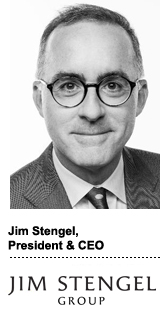
After a quarter-century in marketing roles at P&G – including seven as CMO – you learn a thing or two about how to grow a brand.
Jim Stengel started at P&G in 1983 as a brand assistant on Duncan Hines, moving his way up the ranks to marketing chief by 2001. He handed the reins to Marc Pritchard in 2008 with these words of wisdom: Learn how to say no.
“Startups, agencies – everyone wants to work with you and they’ll do anything to work with you,” Stengel said. “I cautioned him on that, because it can suck you in so that you leave exhausted every day and all you’ve done is navigate traffic.”
These days Stengel is a consultant, president and CEO of the Jim Stengel Group, a think tank populated by 12 ex-P&G execs that help brands figure out their raison d’etre and put it into action.
One of Stengel’s clients, Shire, a pharma giant that develops treatments for rare diseases, is in the mist of a project to become more patient-centric in its consumer-facing communications … which is all well and good for Shire, a company that is literally working to save lives. But what about the marketers out there toiling to sell toilet paper? They can have brand purpose, too, Stengel said, they just need to figure out what it is.
When Stengel was a brand manager for Jif peanut butter in the 1980s, he made a point of going into the field to speak directly with its target audience of young mothers. He also spearheaded a campaign where Jif donated money to the local PTA for every jar it sold. Market share popped and so did brand affinity.
AdExchanger caught up with Stengel for his take on what gives advertisers agita, the direct-to-consumer explosion and what tech vendors have to do to get on Marc Pritchard’s good side.
(Fun fact: Stengel was rejected for an internship at P&G before he was eventually hired.)
AdExchanger: What is the top question brands have for you?
JIM STENGEL: My culture is stale, we’re not agile and we’re not attracting the right kind of talent – how do we fix it?
What skill do most CMOs lack and how can they get it?
You wouldn’t think it, but a lot of CMOs aren’t great communicators, in that they’re not clear with their agencies about what they need or clear with their own organizations about priorities. They don’t get outside enough. They’re wrapped up in their own BS and it stresses them out.
What are advertisers afraid of?
Data. They’re like a deer in headlights right now. Brand safety is also an enormous issue.
I run a leadership program for CMOs at Cannes every year at the end of the week and I bring in speakers from different areas of the industry. After I had someone from an ad tech company speak, a very senior marketer at a prominent company came up to me and said, “I had no idea what happens from when we create a message to when someone sees it – holy shit, I need to learn more about this.” They’re still catching up.
You spent 25 years moving up the ranks until you reach the top at P&G, but that’s not the typical career path anymore. What changed?
A lot of companies don’t see marketing as a career. They see it as a job, so they bring in people from sales, product, from IT or finance and say, “Here’s your $500 million budget, here are your 27 agencies – go at it.”
The big CPG companies were blindsided by the direct-to-consumer movement, and now a lot of them are throwing billions at the problem to try and buy their way in. Will that work?
Consumption and spending patterns changed pretty fast, but CPGs saw it coming – they just didn’t move quickly enough. A couple of carefully timed acquisitions now, however, with the goal of extracting learnings and then having the courage to act on those learnings to change the core business will provide them with real value if they can pull it off.
Would you want to be a CMO today?
I’d have to say no. The only really cool job out there today would be leading marketing at Facebook – it’s a big challenge – and a good friend of mine already took that one.
What’s more important, branding or performance?
It’s got to be “and” and not “or.” At P&G, it’s ingrained that everything you do has to be both. Even if you’re running a price promotion, you also need to be building the brand equity. But everyone is also trying to hire more performance marketers today, especially brand equity companies, like SC Johnson, Kraft-Heinz and P&G.
What advice would you give to tech platforms trying to score meetings with CMOs?
If you want to get into Marc Pritchard’s or [JPMorgan Chase CMO] Kristin Lemkau’s head, know that you sound like 20 other companies – or 2,000 other companies, if you’re in ad tech. If you sound even a bit like someone else, you’re not going to get a meeting. Be smart. Invest to understand a marketer’s specific problems. Do some research.
This post was syndicated from Ad Exchanger.


More Stories
Thirst Trap Ahead: Progressive Says Drive Safely Around Calvin Klein’s Bad Bunny Billboards
People Are Surprised JCPenney Is Trendy. Its Comeback Ads Challenge That.
Special PR makes Global PR Agency of the Year shortlist